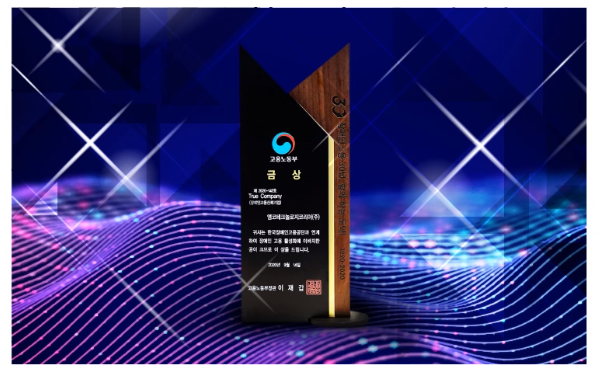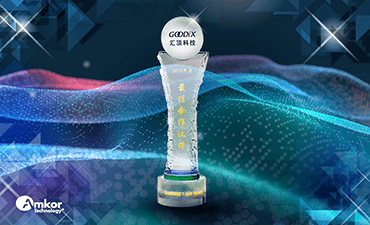5G射频제품 테스트 서비스 당면 과제
5克무선 주파수(射频)표준이 빠르게 시행되고 있습니다[1]. 지난 4 ~ 6 분기 동안 시장에 소개된 간행물과 제품에 대한 관심이 증가하고 있습니다. 휴대전화, 无线网络,자동차, 사물 인터넷(物联网),위치 서비스 등이 가장 인기 있는 射频생태계 애플리케이션의 예입니다. 사물인터넷(物联网)은 한정된 데이터 양만 필요로 하는 반면, 无线网络와 휴대전화 서비스는 데이터 집약적입니다.
4克이동 통신사의 유닛 볼륨 메트릭스에 근거하면, 유닛 볼륨 달성(그림1)에 대한 신뢰도 수준과 5克표준 정의의 총 적용가능한 마켓(塔姆)이 높은 것으로 나타났습니다.

그림 1:5G 제품의 견고한 성장 전망 ,출처: 사물인터넷(IoT) 비즈니스 뉴스
제품을 개발하는 전 세계 지역에서 개발되는 제품의 양부터 5G 사양까지 유사한 양상을 보이고 있습니다. 5G RF 유닛 볼륨이 많이 질수록 테스트해야 할 유닛 수가 늘어납니다. 인프라 구조 개발 및 개발은 사용자 장비 도입을 선행할 것으로 예상합니다. 그림 2에서와같이 일반적인 휴대전화 애플리케이션에는 범위 영역 내에서 다양한 사용자의 휴대전화를 각각 지원하는 휴대전화 타워 기지국이 포함됩니다.

Figure 2:双向射频通信框图的关键组成部分包括应用处理器(AP)、基带集成电路(IC)和射频集成电路(RFIC)。
由于基站具有支持多用户设备的覆盖区域,因此相对于用户设备,RF功率需求更高。基站由插入式电源供电,而用户设备的设计则是为了省电,因为它们是移动的,由电池供电。由于典型手机上下载的数据量比上传的数据量高出几个数量级,因此接收通道的数量通常大于传输通道的数量。在协议层采用诸如多输入、多输出(MIMO)和载波聚合(CA)[1]之类的概念来增加有效带宽。接收信道采用分集[1]来提高空间性能。尽管这些概念不是本文的重点,但产品架构和设计确实对测试需求和测试方法有影响。基于WiFi技术的应用程序通常位于家庭/办公室内。他们的最大射频功率是有限的,但动态范围不是,他们的带宽通常高于手机。
最近5G 3GPP标准的引入[1]在两个单独的载波频谱中识别载波频率。如图3所示,FR1载波频率在410 MHz到7.125 GHz范围内,FR2载波频率在24 GHz到52 GHz范围内。允许的带宽超过100兆赫至2千兆赫。子载波间隔是压缩的,因此需要对相位噪声和增益平坦度进行更严格的约束。
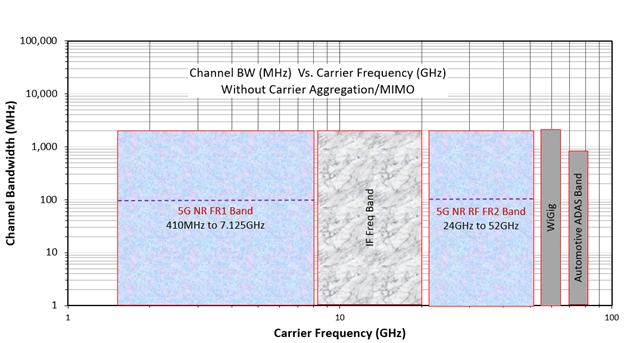
图3:5G载波频率在3GPP规范[1]中定义。
5G NR(New Radio) 변조 방식
有两种5G NR信号调制方案–循环前缀正交频分复用(CP-OFDM)和离散傅里叶变换扩展正交频分复用(DFT-S-OFDM)[1](图4)。
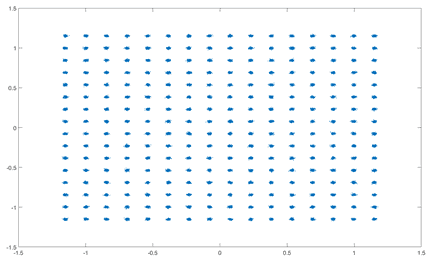
图4:在Adautest V93K上捕获了256正交幅度调制(256-QAM)5G NR星座曲线图。
CP-OFDM is for downlink (D/L), with quadrature phase-shift keying (QPSK), 16-QAM, 64-QAM, and 256-QAM. It has high spectral efficiencies and is compatible with MIMO and 4G LTE definitions. DFT-S-OFDM is for uplink (U/L), with π/2- binary phase-shift keying (BPSK), 16-QAM, 64-QAM, and 256-QAM. It has a more complex implementation and has less flexible resource assignments compared to CP-OFDM and it is not used in combination with MIMO. The five sub-carrier spacings for 5G NR are between 15 kHz to 240 kHz. Figure 4 shows a 256-QAM plot.
5G RF 제품 & RFIO
Modern direct and heterodyne converter architectures [2] have digital baseband I/O. The digital baseband feeds the data to a digital-to-analog converter (DAC) that creates the analog in-phase and quadrature (I/Q) waveforms. These waveforms, when mixed with a local oscillator (LO) signal, up-convert the data to produce the modulated intermediate frequency (IF) or RF signal that is transmitted to the receiver (Rx). The signal transmission occurs over a coaxial shielded cable or over the air. Prior to transmission, especially when it is over the air, the signal may require signal amplification. Also, the receiver may require the received signal to be amplified prior to supplying the signal for down-conversion. The down-converted signal is fed to an analog-to-digital converter (ADC) that converts the signal to digital baseband for processing by the application processor. Figure 5 shows these steps.

图5:简化的发射机(Tx)和Rx射频链块。
Integrated device manufacturer (IDM) customers bring a variety of RF products for assembly and test services. This includes, and is not limited to transceivers, low-noise amplifiers (LNA), power amplifiers (PA), digital step attenuators (DSA), filters, and mixers. Depending on the target application, the number of RF input and output channels may be different. Bandwidth, phase noise, intermodulation distortion (IMD), phase and amplitude resolution/accuracy, and other test requirements may vary as well.
测试设备(DUT)发射机水资源teristic specifications for production testing includes transmitting power and RF spectrum emissions (occupied bandwidth, out of band emissions, adjacent channel leakage ratio (ACLR), and IMD). DUTs Receiver characteristic specifications for production testing include receiving sensitivity, maximum input levels, adjacent channel selectivity, blocking, spurious response, and IMD [1].
5G RF 하위 시스템을 이용한 자동화된 테스트 장비(ATE) 테스터 및 툴링(Tooling)
最近,Teradyne,National Instruments和Cohu最近公开发布了他们成熟的吃的升级路径。AMKOR利用ATE的RF子系统硬件和软件仪器基础架构来测试生产工厂的客户产品。
ATE供应商通常架构架构仪器资源的通用超集配置,以便客户测试应用程序开发。任意波形发生器(AWG),数字化器(DGTS),LOS,滤波器,放大器,音调组合器,传输信号分路器,接收信号交换机,以及它们宽带宽和动态操作范围的折衷和动态的操作范围当前必须考虑的权衡每位客户的新5G RF应用程序。从仪器设计的特定应用频率和振幅处的相位噪声对误差矢量幅度(EVM)测试有直接影响。在100kHz和-10dB或更好的偏移中的相位噪声或更好的是在5G的连续波(CW)频率下是可接受的(典型的)。在典型的宽带客户产品应用中,需要切换频率和幅度。切换时间影响整个测试列表执行时间。具有最小切换时间的测试人员是生产测试中最有效的。图6示出了ATE框图。
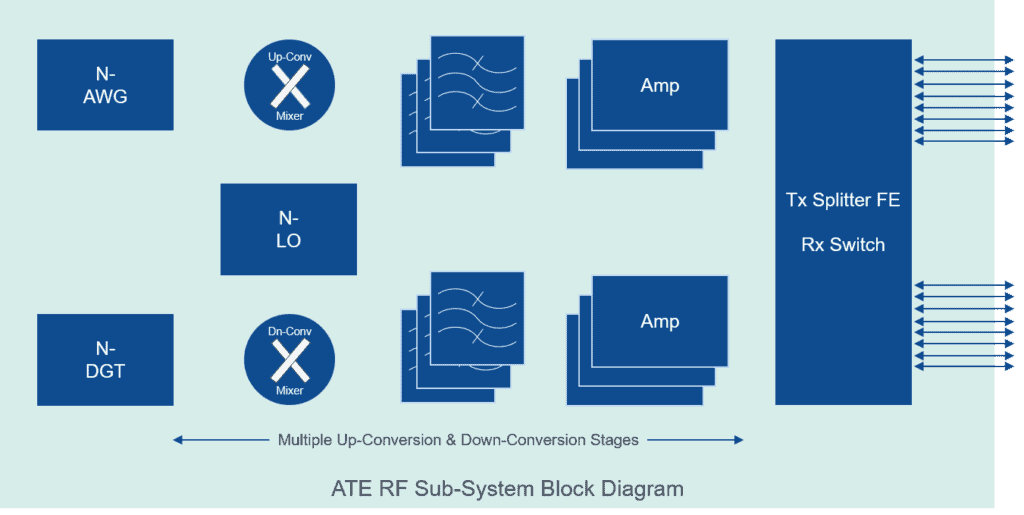
图6:简化的ATE框图。
必须开发定制工具(探针卡和/或加载板),以帮助将测试仪资源路由到设备、引脚或凸起。对于晶圆探针服务,探针卡供应商提供探针针技术。对于50ghz以上的5G射频载波频率,面临的挑战包括阻抗匹配、端到端和端到端信号隔离。对于封装部件,负载板、插座和插座引脚技术供应商提供引脚技术。对于5G射频载波频率,挑战与探针引脚的挑战相似。在这些频率下插入损耗(S参数S21)的可接受水平通常不超过-10db,并且在频率范围上的回波损耗(S11)通常优于-10db。在频率范围内,典型应用的针对针隔离的可接受水平优于-45 dB。
RF performance and accuracy specifications are guaranteed by the supplier to the test head signal delivery interface. The tester supplier develops and delivers calibration systems (hardware and software) to calibrate, verify, and diagnose performance within documented specifications. RF instruments’ accuracy specifications are sensitive to temperature fluctuations. In most cases, a ±5°C (or tighter) change in temperature triggers the instrument’s self-calibration routines. Power, signal (digital, analog/RF), and clocks require moving the calibration plane from the test head to the device pin. This path includes the traces on the probe card or load board. We have a unique benefit of either employing de-embedding techniques and using loopback or custom-developed Short, Open, Load, Through (SOLT) structures to help deliver the required RF signal accuracies to the device under test. Developing custom standards for calibration in most cases requires additional efforts, however, with in-house package designs, the avenue does exist. In most cases, golden loopback DUT techniques have been sufficient to achieve the desired accuracies.
Assembly-Test Attach
我们的装配和测试部门密切合作,使5G RF工程开发能够进行生产测试。好处是从同一工厂位置提供的完整组装和测试交钥匙解决方案。5G封装在包装和天线上提供天线(AIP / AOP)SIP是2018年7月的首次由Amkor制作,并在2019年的公共新闻稿中宣布[3]。
随着装配和包装技术的最新进步,RFIC,如5G收发器和RF前端(RFFE)设备,可以在包装中嵌入天线。类似地,包装(SIP)设备中的系统具有相同的相关组件,如处理器,存储器,RFIC外设,包括功率放大器,低噪声放大器,相位阵列和IC包内的天线结构的离散组件[4]。天线形成前端的关键组件,并且需要调谐特定频带的操作。如今所定义的,今天正在设计的5G NR FR2兼容客户产品正在进行于特定操作频段的性能调整[1]。数据密集型应用可能需要在包装中打包多个无线电,因此需要每个频带调谐的多个天线。
All production testing of previous and present generations of RF devices has been conductive. RF I/O from and to the DUT are electrically connected with impedance-controlled paths over cables and shielded printed circuit board (PCB) micro-traces to the tester’s RF instrumentation. As described above, all ATE suppliers developing 5G RF test solutions include a conductive RF coaxial interconnect. To enable high-volume production testing of packages with an embedded antenna, the test methodology requires an interconnect that can transmit or receive RF energy with minimal and controlled signal loss. Antenna transmission theory [7], requires minimal spatial separation between the transmitter and the receiver. This separation depends on the carrier frequency. The number of RF I/O channels and multisite test requirements add to the production test complexity. The test options that are presently being explored, include patch and horn antennas, beamforming ICs (BFICs), embedded directional couplers, and waveguides. None of these solutions is high-volume manufacturing friendly nor are they scalable as the number of antenna increases. This is primarily due to the physical space requirement in the handler at the tester interface.
IDMs have been architecting design structures that allow loopback Design for Excellence (DfX) modes on transceivers to help simplify and make production test equipment requirements economical. While an antenna embedded within the package offers added miniaturization and overall integration, it does take away the flexibility of final performance tuning of the application for the new 5G NR operating band of carrier frequencies. The company continues to partner with suppliers and customers to solve the over-the-air (OTA) test challenges for production testing.
부가가치 제안
상위레벨에는두가지주요생산테스트운영모델이있습니다。첫번째테스트 운영 모델은 고객이 테스트 컨텐츠와 5G RF 테스트 장비를 선정하여 앰코가 생산에 사용하도록 하는 것입니다. 두 번째 테스트 운영 모델은 생산 테스트를 가능하게 하는 고객 요청 엔지니어링 서비스를 제공합니다. 이 경우, 테스트 개발 팀은 고객과 긴밀히 협력하고 각 고객의 테스트 개발 엔지니어링(TDE) 요구 사항에 맞는 맞춤형 요구사항을 충족합니다. 부가적인 TDE 서비스의 예는 다음을 포함하지만 이에 국한되지 않습니다:
- 일치하는 5G 지원 테스터 선택
- 일치하는 프로버 및 핸들러 선택
- 적절한 테스터 리소스 할당, 특히 다중 사이트 생산 테스트를 위한 일치하는 5克테스트 툴(프로브 카드, 로드 보드) 설계
- Developing and debugging production test programs, test patterns, and test waveforms per the customer’s functional test specification,
- 제품 검증,
- 제품 특성 테스트 루틴
- Yield optimization, low yield failure analysis, and product design feedback. (Failure analysis may, for example, require X-ray or de-lamination to determine the root causes of fabrication and assembly packaging defects.),
- 맞춤형 백 엔드 플로우로 완제품을 효율적으로 처리할 수 있습니다.
射频测试开发工程组拥有为前代和当代射频技术开发测试解决方案和测试内容的丰富经验,并将继续利用这一专业知识解决本文所述的5G测试挑战。集团积极致力于为FR1和FR2射频频谱的基站和移动5G射频产品创建和提出测试解决方案。这些测试解决方案利用了上述符合3GPP标准的ATE硬件和软件测试工具。
多年来内部生产测试过程已经成熟,并允许实施制造(DFM)规则设计为5G RF生产测试。收集,分析和保留5G RF生产试验的制造测试结果对于对测试方法,流动和内容的增量改进至关重要。在特定情况下,测试工程师为IC设计和制造工艺工程提供有价值的反馈。建立了5G RF测试结果的统计箱限制(SBL)在测试设备船队中为多射频测试结果可以帮助识别系统的设备相关的虚假故障,并帮助消除这些因素。这确保了最佳的测试设备利用率并提高了整体生产吞吐量。
A good portion of customers have products with critical time-to-market (TTM) goals and are sensitive to intellectual property (IP) contamination and security. Mature systems and processes are in place to handle all such customer concerns.
Amkor production test has been preparing to test the large number of 5G products that are expected in the coming years. This includes the 5G base station and infrastructure equipment that is expected to precede user equipment (mobile devices) growth.
요약
The 5G RF production test business is substantial in size and growing rapidly. Our production test teams have been working closely with assembly packaging, ATE suppliers, and customers to ensure that holistic 5G RFproduction test services可满足并超过所有测试能力和容量挑战。
참고 자료
- 3GPP.TS 38.101-1 V16.1.0(2019-09)。
- Wide Band RF Architecture options – Peter Delos,模拟设备.
- Amkor Device Packages
- 包装内天线/包装上天线
- Amkor Antenna in Package –文章.
- Amkor套餐——2019年新闻稿
- Fresnel Far Field Region或Antenna Theory
작성자 정보
vineet pancholi., Sr Director Test Technology at Amkor Technology, Inc. in Tempe, AZ. Vineet joined Amkor in January 2019 and currently leads test technology development for 5G RF and high-speed digital production test methodologies. Before joining Amkor, Vineet worked in test development at Microchip Technology. Prior, he spent 19 years at Intel in a variety of test roles, including tester supplier management, test technology development (burn-in, final and system level test) and RF tester architect. Vineet holds a patent on semiconductor device testers and has earned master’s degrees in physics and electrical engineering from Arizona State University.

